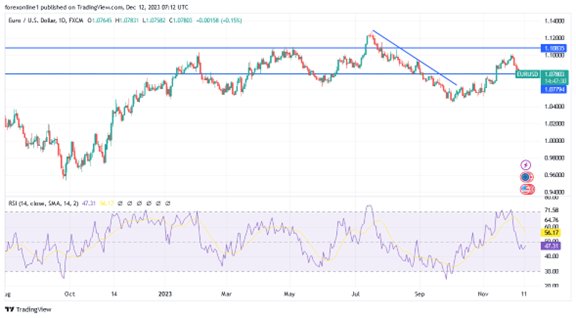The EUR/USD exchange rate is back under pressure and vulnerable to further losses unless the European Central Bank can "conquer" the US Federal Reserve’s policy course this week. Recently, The EUR/USD price stabilizes around the level of 1.0780 at the time of writing the analysis. by the end of last week’s trading, it collapsed to the support level of 1.0723. technically, the bears’ control remains the strongest over the performance of the currency pair.
Last week, the price of the US dollar rebounded and rose against all G10 currencies except the Japanese yen. Meanwhile, the euro fell sharply in December, driven primarily by the recent cautious repricing of the European Central Bank's policy expectations. Shortly, the result is that EURUSD has fallen back to the middle of this year's trading range between 1.05000 and 1.1000.
In the process, the exchange rate fell below the 200-day moving average, which could lead to a significant technical deterioration in the medium-term outlook. This technical breakdown indicates that the trend has shifted in Favor of further downside, but we will not place much weight on the technical setup in a week full of important and influential economic data events.
Moreover, there is a good chance the euro will make a comeback in the coming days as the repricing of European interest rate expectations reaches its maximum and is vulnerable to a reversal, at least to some extent. Generally, the euro has been lagging behind the G10 currencies as markets moved to price in cuts of more than 150 basis points for next year, which equates to two additional interest rate cuts compared to pricing just two weeks ago. The European Central Bank is expected to make five interest rate cuts in 2024, with the first step expected in March.
For the euro, how the markets adjust after the European Central Bank's decision next Thursday will determine the price movement. As, it is difficult to see how markets could become more aggressive in dealing with such pricing.
Visibly, the euro price could get better support when financial markets calm their expectations about the European Central Bank and reflect expectations of interest rate cuts. In this regard, economists at Commerzbank say that the European Central Bank “will seek to reduce market expectations for faster cuts in interest rates,” as inflation will only fall to the 2.0% target in 2025. For his part, Jörg Cramer, chief economist at Commerzbank, says: “Some reasons speak against rapid interest rate cuts.” “The strong rise in wages remains inconsistent with a sustainable return of the inflation rate to the European Central Bank’s target in the near future.”
Substantially, the expectations of an interest rate hike by the US Federal Reserve have also emerged. Thus, the dollar could also benefit if the US Federal Reserve opposes this development in its policy decision and guidance update in the middle of the week.
In general, the most prominent event for the dollar this week is the US Central Bank’s monetary policy decision scheduled for mid-week at 7 pm GMT. As, US interest rates are expected to remain unchanged. Moreover, the December meeting brings a new set of expectations, which, coupled with Chairman Jerome Powell's latest guidance, will move markets. Meanwhile, the markets had raised expectations that US interest rate cuts by the Federal Reserve would begin around June. Furthermore, those expectations were verified on Friday with a US Labor market release that beat consensus. Obviously, a strong set of jobs and wages numbers reminded markets that the US economy remains resilient, and it is too early to expect interest rate cuts, giving the dollar a boost against other major currencies.
EUR/USD technical Analysis Today:
There is no change in our technical view of the performance of the price of the EUR/USD currency pair. Nearby, the general trend is still bearish, which is the most prominent according to the performance on the daily chart below. Therefore, breaking the support at 1.0800 still supports the strength of the bears’ control over the trend. Furthermore, if the European Central Bank confirms the markets’ expectations this week that interest rates will soon be cut. Moreover, the euro’s losses may increase, and the next most important support levels may be 1.0700, 1.0655, and 1.0580, respectively. Clearly, there are sufficient levels to push the technical indicators towards strong oversold levels.
On the other hand, over the same period, the psychological resistance of 1.1000 will remain the key to the bulls’ strength in controlling the trend again. Recently, the Euro/Dollar will remain on its current path until the reaction to the announcement of US inflation numbers today and then the central bank announcements the rest of the week.


